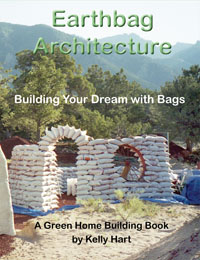| Freeform Earthbags Between Boulders by Julien L. Balmer |
Koh Phangan, Thailand, June 2009 – February 2010
After a couple of months of familiarizing ourselves with the subject of earthbag construction, be it by reading books (most notably Kaki Hunter’s and Donald Kiffmeyer’s Earthbag Building), websites (such as this one), or talking to Owen Geiger on email (big thanks for all the support!), I felt well-prepared and ready to kick off.
Given the somewhat remote location of our jungle hillside property on beautiful Koh Phangan in the southern gulf of Thailand and the inexistent access to the building site, many tons of earth were moved manually. We began lowering the ground level between the large boulders which took an average of four guys an entire month. There were many many smaller rocks that needed to be rolled out, some of them requiring four people’s attention and energy for a whole afternoon to cover the distance of only a few meters. Next were the earthbag walls, for which we mixed two different soils (one rich in clay, a beautiful red soil, used here on the island as roadbase, the other sandy in nature). Roughly 25 tons of dirt went into bags in order to form both exterior and interior dividing walls. Sticking to the principles of organic shapes and free-form construction, a point was made in avoiding corners which tend to trap energies, on a subtle level.
We used cheap and readily available cement rings (used for wells) for windows and “doors”, and later simply covered them with a sturdy high-grade mosquito screen, which went in before the render stage. Keeping the building open as much as possible was of primary importance in order to allow the breeze to flow freely through the structure at all times.
We then erected the two main poles, and began working on the intricate roof. I worked with five local carpenters for six weeks to finish both the roof and the interior loft. Seven cubic meters of a regional soft wood called “takien ra” were used to build it all. The massive rafters (2” x 6”) were spaced at only 50cm from each other, for entirely aesthetic and not structural reasons.
The roof is covered with very light “jaak nam”, a local palm thatch with an expected life expectancy of 4-6 years. Contrary to what some people think and write, such an organic roof is 100% waterproof. Once the tiles “expire”, they are taken down (1 day of work) and replaced with new tiles (3 days of work). We next rendered the earthbag walls, using a mixture of beautifully yellow soil (55%), coarse sand (30%), white cement (15%), plus some yellow and red iron oxide. In order to avoid metal (for energetic reasons), we resorted to nylon fishing net for extra render support instead of the frequently used varieties of chicken wire. Ideally the plaster on an earth wall would not contain cement at all, but given the absence of both local clay and a fibrous material such as straw, adding a bit of cement to stabilize the earth seemed the best course of action.
Great importance was given to long eaves all around the house, for a dual reason: 1) to protect the walls at all times from direct exposure to sun (massive earth walls such as earthbag walls store both cold and heat very well, and in a tropical climate such as ours one wants to have a pleasantly cool house at all times), 2) to protect the render from the heavy rains, particularly during the monsoon months. The interior stucco only white cement and fine sand were used. The floors have either a gravel or stone base to prevent water from coming up from the ground. We either did a couple of layers of pure roadbase earth, or a mix of regular portland cement (8%) mixed with coarse sand (16%), gravel (38%) and a very generous amount of soil (38%) to stretch the mix and economize on materials. The top coat is white cement (30%) and fine sand (70%) plus yellow iron oxide. The whole structure cost about 21,000 USD, including a simple 300 Watt solar system to power lights and this laptop, as well as an outdoor kitchen which was added in June 2010.
The house “performs” well, meaning it is pleasantly cool even at midday when outdoor air temperatures are noticeably higher than indoors.
This rather luxurious “cave” artfully combines granite, wood and earth. It has a 60 sqm ground floor divided into three rooms on 3 levels, topped by a 15 sqm loft. While the earthbag walls elegantly fill gaps between large boulders, the double roof structure is elliptic in shape and rests on two Sandalwood poles which previously served as main masts on a sailing boat. Corners are entirely absent, and a feeling of peace and tranquility prevails. |













